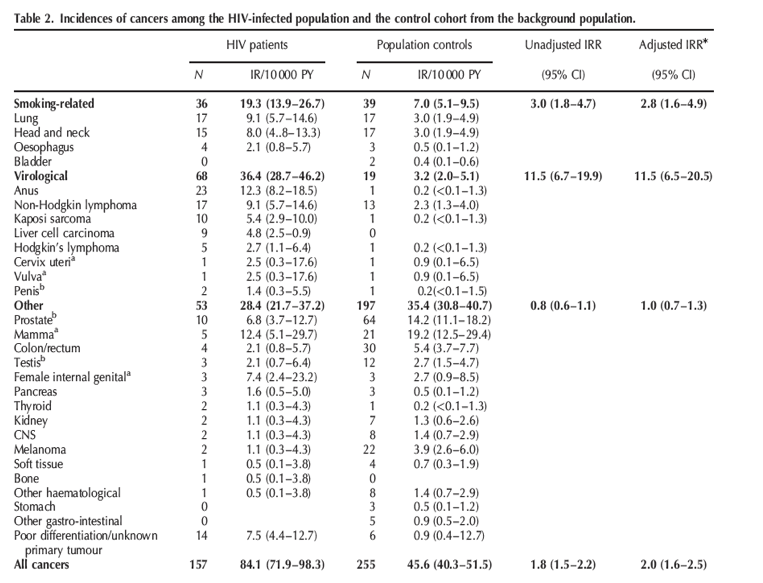| |
Risk of cancer among HIV-infected individuals
compared to the background population: impact of smoking and HIV
|
| |
| |
Download the PDF here
AIDS April 30 1024
Helleberg, Marie; Gerstoft, Jan; Afzal, Shoaib; Kronborg, Gitte; Larsen, Carsten S.; Pedersen, Court; Bojesen, Stig E.; Nordestgaard, Borge G.; Obel, Niels
as presented at CROI 2014: Impact of Smoking on Risk of Cancer among HIV patients Compared to the Background Population........http://www.natap.org/2014/CROI/croi_90.htm
"In this nationwide, population-based cohort study, we found that HIV patients, with long-term engagement in care, had increased risk of cancers that are considered strongly related to smoking or viral infections. In contrast, they did not have increased risk of other cancers compared to the background population. We found no association between immune deficiency and non-virological cancers that are not strongly related to smoking......Non-smoking HIV patients did not have increased risk of non-virological cancers compared to non-smoking controls......Immune deficiency had no impact on risk of non-virological cancers in absence of smoking in this population, where 75% of the HIV patients were on antiretroviral therapy (ART) at time of study inclusion and 92% of observation time was during ART"
"We conclude that in a HIV-infected population with long-term engagement in care, the risk of cancer is increased approximately two-fold compared to the background population. The risk is increased for smoking-related and virological cancers, whereas the risk of other cancers does not differ between HIV-infected and uninfected individuals, and does not seem to be associated with immune deficiency. Among nonsmokers, the increase in risk of cancer associated with HIV infection is confined to cancers related to viral infections."

------------------------------
Risk of cancer among HIV-infected individuals compared to the background population: impact of smoking and HIV.
Helleberg, Marie; Gerstoft, Jan; Afzal, Shoaib; Kronborg, Gitte; Larsen, Carsten S.; Pedersen, Court; Bojesen, Stig E.; Nordestgaard, Borge G.; Obel, Niels
The objective of the present study was to estimate the population-attributable fractions (PAFs) of cancer that are associated with smoking, immune deficiency and with being HIV-infected. We therefore compared the incidence rates of cancer in the HIV-infected population with those of a matched cohort from the background population. Analyses were stratified on smoking status and nadir CD4?/duration of CD4? below 200 cells/ml, and cancers were categorized as smoking-related, related to viral infections or 'other'.
Cancers were coded according to the International Classifications of Diseases, 10th version (ICD-10). Cancers, in which data from WHO indicate that the proportion attributed to smoking is above 40%, were classified as smoking-related [18]. Cancers categorized as smoking-related were: lung cancer (C34), head and neck cancer (C0-C14 and C30-C32), oesophagus cancer (C15) and bladder cancer (C67). Cancers classified as virological were: lymphomas (C81-C86), Kaposi sarcoma (C46), liver cell carcinoma (C22.0), anal cancer (C21), cervical cancer (C53), vulva cancer (C51) and penile cancer (C60). All other cancers were categorized as 'other'. We did not include non-melanoma skin cancers (C44).
Abstract
Background: The relative impact of immune deficiency and lifestyle-related factors on risk of cancer in the HIV-infected population is controversial. We aimed to estimate the population-attributable fractions (PAFs) associated with smoking, being HIV-infected and with immune deficiency.
Methods: In a Danish, nationwide, population-based cohort study (1995-2011), incidences of cancer were compared between an HIV-infected cohort and a population-based matched cohort in analyses stratified on cancer category, smoking status and for HIV patients: low CD4+ cell count.
Results: We included 3503 HIV patients [baseline CD4+ 450 cells/[mu]l (inter-quartile range 310-630)] and 12 979 population controls. Smoking-related and virological cancers accounted for 23 and 43% of cancers in the HIV-infected population. The risk of these cancers were higher among HIV patients compared to controls [incidence rate ratio (IRR) 2.8, 95% confidence interval (CI) 1.6-4.9; and IRR 11.5, 95% CI 6.5-20.5], whereas the risk of other cancers did not differ (IRR 1.0, 95% CI 0.7-1.3). Non-smoking HIV patients did not have increased risk of non-virological cancers compared to non-smoking controls (IRR 1.2, 95% CI 0.7-2.1). The PAFs of cancer associated with smoking and with being HIV-infected were 27 and 49%, respectively. For cancers not strongly related to smoking or viral infections, the PAFs associated with being HIV-infected and with immune deficiency were 0%.
Conclusion: The risk of cancer is increased in HIV patients compared to the background population. In absence of smoking, the increase in risk is confined to cancers related to viral infections, whereas the risk of other cancers is not elevated and does not seem to be associated with immune deficiency.
A number of studies have demonstrated higher levels of markers of inflammation and immune activation in HIV-infected individuals and shown associations with all-cause mortality [7]. It has been hypothesized that HIV-infection causes accelerated aging, but the relative contributions of immunodeficiency versus lifestyle-related factors, such as smoking, substance abuse and sexual behaviour to morbidity and mortality, among HIV-infected individuals are controversial [8,9]. We have previously shown that smoking is associated with a larger loss of live years
|
|
| |
| |
|
|
|